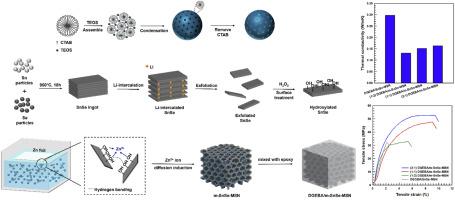用于防止锂离子电池热失控的耐高温锡/MSN 薄膜
IF 12.7
1区 材料科学
Q1 ENGINEERING, MULTIDISCIPLINARY
引用次数: 0
摘要
近年来,在抑制碳排放的迫切需要推动下,电动汽车(EV)加速发展。锂离子电池(LIB)因其能量密度高、循环寿命长而成为首选的储能解决方案。然而,热失控(TR)的持续威胁仍然是一个重要的安全问题。为了解决这一问题,本研究引入了一种新型复合绝缘膜,专门用作 LIB 的热屏障。这种复合材料由剥离硒化锡(SnSe)和介孔二氧化硅组成,通过锌离子凝胶化结合,具有 0.131 W/mK 的低热导率和 52.7 MPa 的抗拉强度。这些特性源于材料的独特混合以及锌离子凝胶化促进的强大界面相互作用,从而提高了热稳定性和机械弹性。设计出的 DGEBA/SnSe-MSN 复合材料具有显著的阻燃性能和卓越的热管理能力,因此有望成为提高锂电池安全性和可靠性的候选材料。这项研究提出了一种很有前途的方法,利用 SnSe 作为绝缘材料,制作出适用于各行各业的高性能绝缘薄膜,特别是在锂离子电池技术领域,这与 SnSe 以前作为热电材料的应用不同。本文章由计算机程序翻译,如有差异,请以英文原文为准。

Recent years have witnessed an accelerated development of electric vehicles (EVs) driven by the pressing need to curb carbon emissions. Lithium-ion batteries (LIBs) stand out as preferred energy storage solutions owing to their high energy density and extended cycle life. Nonetheless, the persistent threat of thermal runaway (TR) remains a critical safety concern. This study endeavors to tackle this issue by introducing a novel composite insulating film tailored to function as a thermal barrier within LIBs. Comprising exfoliated SnSe (tin selenide) and mesoporous silica bonded via Zn ion gelation, the composite showcases a low thermal conductivity of 0.131 W/mK alongside a robust tensile strength of 52.7 MPa. These attributes stem from the distinctive amalgamation of materials and the robust interfacial interactions facilitated by Zn ion gelation, thus enhancing thermal stability and mechanical resilience. The devised DGEBA/SnSe-MSN composite exhibits notable flame retardant properties and superior thermal management capabilities, positioning it as a promising candidate to bolster the safety and dependability of LIBs. This research introduces a promising approach for crafting high-performance insulating films applicable across diverse industries, particularly in the realm of lithium-ion battery technology, leveraging SnSe as an insulating material—a departure from its prior application as a thermoelectric material.
求助全文
通过发布文献求助,成功后即可免费获取论文全文。
去求助
来源期刊

Composites Part B: Engineering
工程技术-材料科学:复合
CiteScore
24.40
自引率
11.50%
发文量
784
审稿时长
21 days
期刊介绍:
Composites Part B: Engineering is a journal that publishes impactful research of high quality on composite materials. This research is supported by fundamental mechanics and materials science and engineering approaches. The targeted research can cover a wide range of length scales, ranging from nano to micro and meso, and even to the full product and structure level. The journal specifically focuses on engineering applications that involve high performance composites. These applications can range from low volume and high cost to high volume and low cost composite development.
The main goal of the journal is to provide a platform for the prompt publication of original and high quality research. The emphasis is on design, development, modeling, validation, and manufacturing of engineering details and concepts. The journal welcomes both basic research papers and proposals for review articles. Authors are encouraged to address challenges across various application areas. These areas include, but are not limited to, aerospace, automotive, and other surface transportation. The journal also covers energy-related applications, with a focus on renewable energy. Other application areas include infrastructure, off-shore and maritime projects, health care technology, and recreational products.
 求助内容:
求助内容: 应助结果提醒方式:
应助结果提醒方式:


